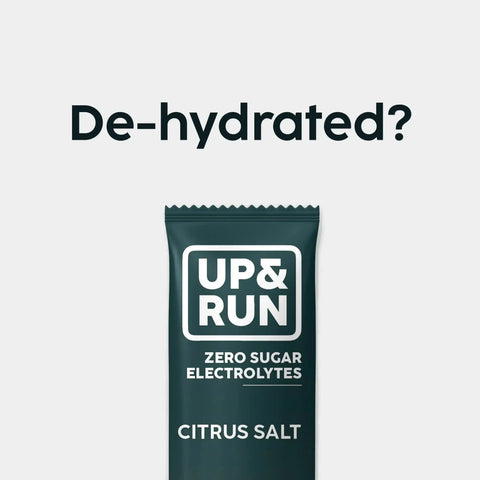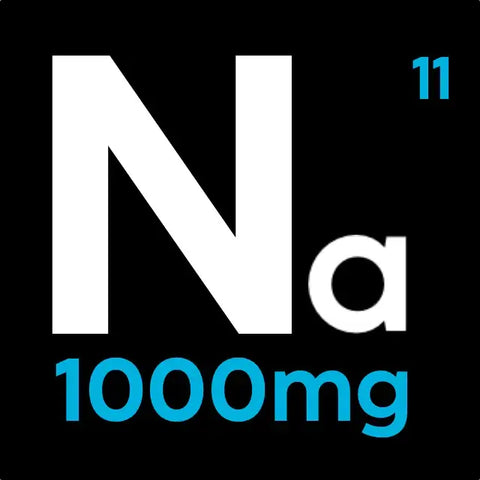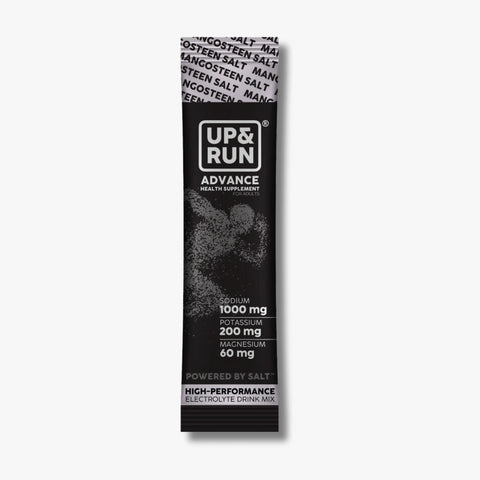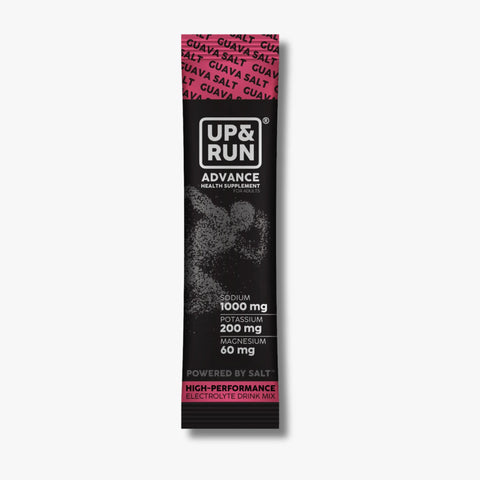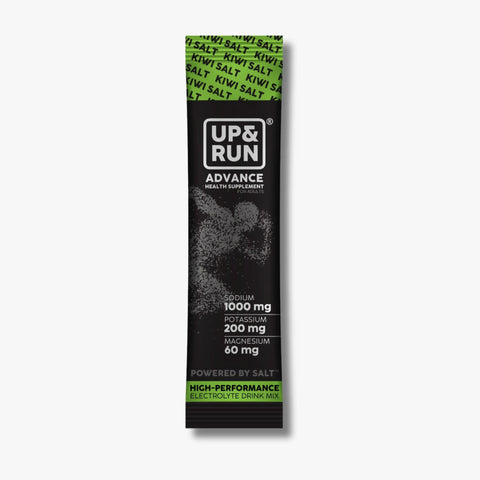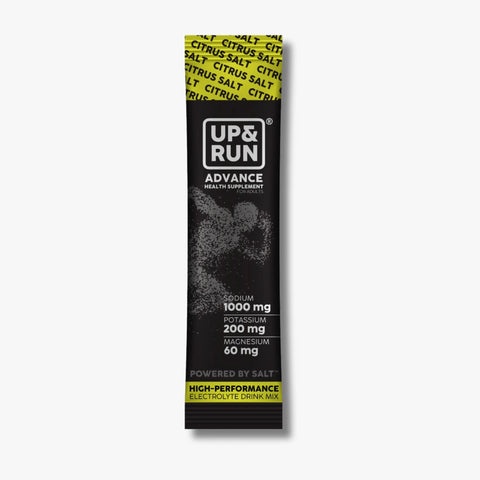
How UP&RUN helps you stay hydrated in India's challenging climate
India's diverse climate presents unique hydration challenges for athletes and fitness enthusiasts. From the scorching heat of Rajasthan to the humid conditions of Mumbai, understanding dehydration becomes crucial for optimal performance and health. This comprehensive guide breaks down everything you need to know about staying hydrated while pursuing your fitness goals with UP&RUN.
Understanding Dehydration in the Indian Context
Your body consists of approximately 60% water, making proper hydration essential for peak performance. In India's varied climate conditions, dehydration occurs when you lose more fluids than you consume—a common scenario during outdoor workouts, monsoon season training, or high-altitude running in hill stations like Manali.
The human body maintains fluid balance through a sophisticated system involving kidneys, hormones, and essential electrolytes like sodium, potassium, and magnesium. This delicate balance becomes even more challenging in India's climate extremes.
Why Indian Athletes Face Unique Hydration Challenges
-
Climate Diversity: India's six distinct seasons create varying hydration needs. Summer temperatures can soar above 45°C in northern plains, while coastal areas maintain high humidity year-round. (India Meteorological Department)
-
Cultural Factors: Traditional Indian diets, while nutritious, often include dehydrating elements like excessive tea consumption and spicy foods that increase fluid requirements.
-
Air Quality: Poor air quality in urban areas like Delhi and Mumbai can increase respiratory water loss, particularly affecting runners and cyclists.
Common Causes of Dehydration in Indian Conditions
Environmental Factors
-
Extreme Heat: Summer temperatures exceeding 40°C increase sweat production dramatically (Heat stress and dehydration)
-
High Humidity: Coastal cities with 80%+ humidity reduce sweat evaporation efficiency.
-
Monsoon Challenges: Intense rain followed by high humidity creates unique hydration needs.
-
Air Pollution: Increased breathing rate in polluted air accelerates fluid loss.
Lifestyle Factors
-
Excessive Chai Consumption: India's beloved tea culture can contribute to dehydration when consumed in large quantities (Does tea dehydrate you?)
-
Spicy Food: Traditional Indian cuisine's spice content increases internal heat and fluid requirements.
-
Work Environment: Long hours in air-conditioned offices can reduce thirst sensation.
-
Festival Seasons: Extended celebrations often disrupt regular hydration habits.
Athletic Activities
-
Early Morning Runs: Popular in Indian cities to avoid heat but often leads to inadequate pre-hydration.
-
Cricket and Football: Extended outdoor play in heat increases dehydration risk.
-
Yoga and Hot Yoga: Intense sessions, especially Bikram yoga, demand careful hydration planning.
-
Cycling: Long rides on Indian roads expose athletes to direct sun and pollution.
Recognizing Dehydration Symptoms
Early Warning Signs
Understanding these symptoms can help you address dehydration before it impacts your performance:
Physical Symptoms:
-
Persistent thirst despite water intake
-
Dry, sticky mouth and reduced saliva production
-
Fatigue that doesn't improve with rest
-
Headaches, particularly during afternoon heat
-
Dizziness when standing up quickly
Performance Indicators:
-
Reduced endurance during workouts
-
Difficulty concentrating on training routines
-
Increased heart rate during normal activities
-
Muscle cramps during or after exercise
Visual Cues:
-
Dark yellow urine (healthy urine should be pale yellow)
-
Reduced urination frequency
-
Skin that remains "tented" when pinched
-
Sunken eyes or cheeks
Severe Dehydration Warning Signs
Seek immediate medical attention if you experience:
-
Rapid heartbeat or breathing difficulties
-
Confusion or disorientation
-
Fainting or severe dizziness
-
No sweating despite heat exposure
-
Extremely dark urine or no urination for 8+ hours
Debunking Common Hydration Myths
Myth 1: "8 Glasses of Water Daily Is Enough for Everyone"
Reality: In India's climate, this one-size-fits-all approach fails. A cricket player in Chennai needs significantly more fluids than someone doing yoga in Shimla. Your hydration needs depend on:
-
Local climate conditions
-
Activity intensity and duration
-
Individual body composition
-
Health status and medications
Myth 2: "Thirst Is a Reliable Hydration Indicator"
Reality: By the time you feel thirsty in India's heat, mild dehydration has already begun. The body's thirst mechanism becomes less sensitive with age and can be affected by:
-
Spicy Indian foods that mask thirst signals
-
Air conditioning that reduces environmental cues
-
Medications commonly used in India
Myth 3: "Clear Urine Means Perfect Hydration"
Reality: While pale yellow indicates good hydration, completely clear urine might suggest overhydration, particularly dangerous during long-duration activities like marathon training.
Myth 4: "Sports Drinks Are Always Better Than Water"
Reality: For typical 30-45 minute workouts in moderate conditions, water suffices. However, extended activities in Indian heat require electrolyte replacement.
Essential Hydration Facts for Indian Athletes
Climate-Specific Considerations
-
Summer Strategy: In peak summer (April-June), increase fluid intake by 20-30% above normal requirements. Pre-hydrate before stepping outside.
-
Monsoon Adaptation: High humidity reduces sweat evaporation, making internal temperature regulation more challenging. Focus on gradual, consistent hydration.
-
Winter Awareness: Cold weather in North India can reduce thirst sensation, yet heated indoor environments increase fluid needs.
Food-Based Hydration
Indian cuisine offers excellent hydration options:
-
Water-rich fruits: Watermelon, cucumber, oranges, and coconut water
-
Traditional drinks: Lassi, buttermilk, and lemon water
-
Vegetables: Bottle gourd, ridge gourd, and leafy greens
-
Seasonal options: Sugarcane juice, fresh lime soda, and tender coconut
Performance Impact
Even 2% dehydration can reduce:
-
Physical performance by 10-15%
-
Cognitive function by 30% and reaction time by 15%
-
Temperature regulation efficiency
-
Recovery speed after exercise
UP&RUN's Hydration Solutions
Timing Your Hydration
-
Morning Runners: Start hydrating the night before early morning runs. Keep water by your bedside and drink immediately upon waking.
-
Evening Athletes: Begin increasing fluid intake 2-3 hours before evening workouts to account for day-long fluid loss.
-
Weekend Warriors: Plan hydration around longer training sessions with structured pre-, during-, and post-exercise protocols.
Customized Hydration Plans
Climate-Based Adjustments:
-
Hot and Dry (Rajasthan, Gujarat): Increase baseline fluid intake by 25-30%
-
Hot and Humid (Mumbai, Kolkata): Focus on electrolyte replacement
-
Moderate Climate (Bangalore, Pune): Standard hydration with activity-based adjustments
-
Cold Weather (Hill stations): Maintain consistent intake despite reduced thirst
Activity-Specific Protocols:
-
Running: 200ml every 2-3km during long runs
-
Cycling: 250ml every 15-20 minutes
-
Team Sports: Hydrate during natural breaks
-
Gym Workouts: Sip between sets, finish 300-500ml per hour
Advanced Hydration Strategies
Electrolyte Balance
Understanding electrolyte needs becomes crucial in India's climate:
-
Sodium: Lost heavily through sweat, especially important during summer training
-
Potassium: Available in bananas, coconut water, and oranges
-
Magnesium: Often deficient in Indian diets, crucial for muscle function
Hydration Timing for Optimal Performance
Pre-Competition:
-
3 days before: Ensure consistent hydration
-
1 day before: Increase intake by 20%
-
2 hours before: Drink 500ml with light salt
-
15 minutes before: Final 200ml
During Competition:
-
Set reminders every 15-20 minutes
-
Use sports drinks for events over 60 minutes
-
Monitor individual tolerance to avoid stomach issues
Recovery Phase:
-
Immediate: 1.5x fluid lost through sweat
-
Next 2 hours: Continue regular sipping
-
Next 24 hours: Maintain elevated intake
Monitoring Your Hydration Status
Daily Checks:
-
Morning urine colour (urine color chart) (pale yellow is ideal)
-
Body weight changes (>2% loss indicates dehydration)
-
Thirst levels throughout the day
-
Energy and concentration levels
Athletic Monitoring:
-
Pre/post-exercise weight measurements
-
Sweat rate calculations for personal planning
-
Performance consistency tracking
-
Recovery time monitoring
Special Considerations for Indian Athletes
Regional Adaptations
-
Northern India: Account for extreme seasonal variations, air pollution in cities
-
Southern India: Manage consistent heat and humidity, utilize coconut water
-
Coastal Areas: Address high humidity, salt replacement needs
-
Hill Stations: Maintain hydration despite reduced thirst at altitude
Cultural Integration
-
Work-Life Balance: Integrate hydration into Indian work culture
-
Social Events: Plan around festivals and celebrations
-
Travel: Adjust for domestic travel across climate zones
-
Family Meals: Incorporate hydrating foods into traditional meals
Common Mistakes to Avoid
-
Over-reliance on Thirst: Don't wait until you feel thirsty
-
Ignoring Urine colour: The simplest indicator of hydration status
-
Excessive Plain Water: Can dilute electrolytes during long activities
-
Neglecting Food Sources: Miss out on 20-30% of daily fluid intake
-
Inconsistent Timing: Irregular hydration patterns reduce effectiveness
Conclusion
Mastering hydration in India's diverse climate requires understanding your individual needs, environmental challenges, and activity demands. With UP&RUN's comprehensive approach, you can optimize your hydration strategy for peak performance while respecting your body's natural signals.
Remember that proper hydration extends beyond just drinking water—it encompasses electrolyte balance, timing, and integration with your overall fitness journey. By following these evidence-based strategies adapted for Indian conditions, you'll enhance your performance, improve recovery, and maintain optimal health throughout your athletic pursuits.
Stay hydrated, stay salty, and let UP&RUN guide you toward your fitness goals, regardless of the climate challenges you face.
For personalized hydration plans and expert guidance tailored to your specific needs and local conditions, consult with UP&RUN's certified nutritionists and fitness experts.


